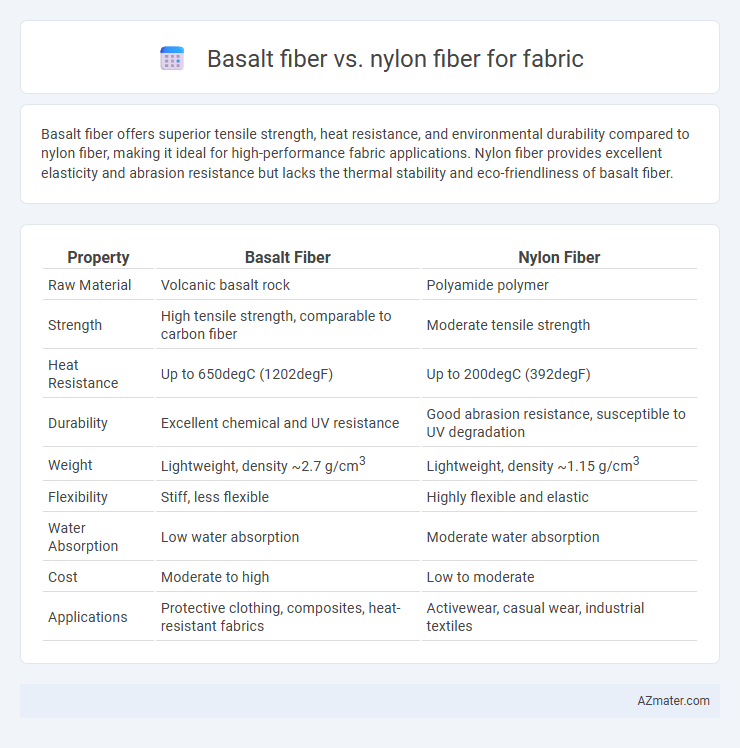Basalt fiber offers superior tensile strength, heat resistance, and environmental durability compared to nylon fiber, making it ideal for high-performance fabric applications. Nylon fiber provides excellent elasticity and abrasion resistance but lacks the thermal stability and eco-friendliness of basalt fiber.
Table of Comparison
| Property | Basalt Fiber | Nylon Fiber |
|---|---|---|
| Raw Material | Volcanic basalt rock | Polyamide polymer |
| Strength | High tensile strength, comparable to carbon fiber | Moderate tensile strength |
| Heat Resistance | Up to 650degC (1202degF) | Up to 200degC (392degF) |
| Durability | Excellent chemical and UV resistance | Good abrasion resistance, susceptible to UV degradation |
| Weight | Lightweight, density ~2.7 g/cm3 | Lightweight, density ~1.15 g/cm3 |
| Flexibility | Stiff, less flexible | Highly flexible and elastic |
| Water Absorption | Low water absorption | Moderate water absorption |
| Cost | Moderate to high | Low to moderate |
| Applications | Protective clothing, composites, heat-resistant fabrics | Activewear, casual wear, industrial textiles |
Introduction to Basalt Fiber and Nylon Fiber
Basalt fiber, derived from volcanic basalt rock, offers superior thermal stability, high tensile strength, and excellent resistance to chemical corrosion, making it a durable and eco-friendly choice for advanced fabric applications. Nylon fiber, a synthetic polyamide, is valued for its elasticity, abrasion resistance, and lightweight properties, frequently used in textiles requiring flexibility and durability. Both fibers serve distinct functions, with basalt fiber excelling in high-performance industrial fabrics while nylon is favored in everyday apparel and technical textiles.
Composition and Manufacturing Process
Basalt fiber is made from natural volcanic basalt rock, melted at around 1,400degC and extruded into continuous filaments, offering high thermal stability and resistance to chemicals. Nylon fiber, a synthetic polyamide derived from petrochemicals, involves polymerization of caprolactam or hexamethylene diamine and adipic acid, followed by melt spinning to produce fibers known for elasticity and abrasion resistance. While basalt fiber requires mineral extraction and high-temperature processing, nylon fiber manufacturing relies on chemical synthesis and controlled polymerization, impacting their respective environmental footprints and performance in fabric applications.
Mechanical Properties Comparison
Basalt fiber exhibits superior tensile strength, often ranging between 2800 to 4500 MPa, compared to nylon fiber, which typically has tensile strengths around 70 to 90 MPa. The modulus of elasticity for basalt fiber is significantly higher, approximately 85 to 95 GPa, providing greater stiffness and durability than nylon fibers, which generally have a modulus near 2 to 3 GPa. Basalt fibers also demonstrate enhanced thermal stability and abrasion resistance, making them ideal for high-performance fabric applications where mechanical property retention under stress is critical.
Durability and Longevity
Basalt fiber exhibits superior durability compared to nylon fiber due to its high resistance to heat, chemicals, and UV radiation, making it ideal for long-lasting fabric applications. Nylon fiber offers good mechanical strength but tends to degrade faster under prolonged exposure to sunlight and chemicals. The exceptional longevity of basalt fiber fabrics makes them preferable for industrial uses where extended performance and resistance to environmental factors are critical.
Thermal Resistance and Fire Performance
Basalt fiber exhibits superior thermal resistance compared to nylon fiber, maintaining stability at temperatures up to 870degC, whereas nylon typically degrades around 250degC. Basalt's inherent fire-resistant properties prevent combustion and release minimal toxic smoke, making it ideal for fire performance applications. Nylon fiber, being synthetic, melts and can ignite at elevated temperatures, limiting its use where heat and fire resistance are critical.
Environmental Impact and Sustainability
Basalt fiber is derived from natural volcanic rock, offering a sustainable alternative with lower carbon emissions and higher recyclability compared to petroleum-based Nylon fiber, which relies on non-renewable fossil fuels and produces significant greenhouse gases during manufacturing. The biodegradability and minimal chemical use in basalt fiber production contribute to reduced environmental pollution, whereas Nylon contributes to microplastic pollution and requires energy-intensive processes. Choosing basalt fiber supports circular economy principles by generating less toxic waste and enabling easier disposal or repurposing, enhancing overall environmental sustainability in textile applications.
Cost and Market Availability
Basalt fiber offers higher durability and thermal resistance compared to nylon fiber but comes with a higher production cost, making it less competitive for price-sensitive markets. Nylon fiber remains widely available and cost-effective due to established manufacturing processes and extensive supply chains. Market availability of basalt fiber is limited primarily to niche industries, while nylon dominates mainstream fabric applications due to its affordability and widespread accessibility.
Applications in Fabric and Textiles
Basalt fiber exhibits superior thermal stability, high tensile strength, and resistance to chemical corrosion, making it ideal for industrial textiles, protective clothing, and automotive upholstery. Nylon fiber offers excellent elasticity, abrasion resistance, and moisture-wicking properties, commonly used in sportswear, lingerie, and outdoor fabrics. While basalt fiber enhances durability and fire resistance in technical fabrics, nylon provides flexibility and comfort suited for everyday apparel and performance textiles.
Performance in Extreme Conditions
Basalt fiber exhibits superior thermal resistance, maintaining structural integrity at temperatures up to 982degC, outperforming Nylon fiber, which degrades around 250degC. Its high tensile strength and excellent chemical resistance enable basalt fiber fabrics to withstand harsh environments, including exposure to acids and alkalis, unlike Nylon which is susceptible to UV degradation and moisture absorption. These properties make basalt fiber an ideal choice for applications requiring durability and stability in extreme heat, fire exposure, and corrosive conditions.
Choosing the Right Fiber for Your Fabric Needs
Basalt fiber offers superior heat resistance, high tensile strength, and excellent durability compared to nylon fiber, making it ideal for industrial and outdoor fabric applications requiring enhanced performance and longevity. Nylon fiber excels in elasticity, abrasion resistance, and moisture-wicking properties, making it suitable for activewear, leggings, and lightweight, flexible fabrics. Evaluating the specific requirements for strength, thermal stability, and comfort helps determine whether basalt or nylon fiber best aligns with your fabric needs.

Infographic: Basalt fiber vs Nylon fiber for fabric
 azmater.com
azmater.com